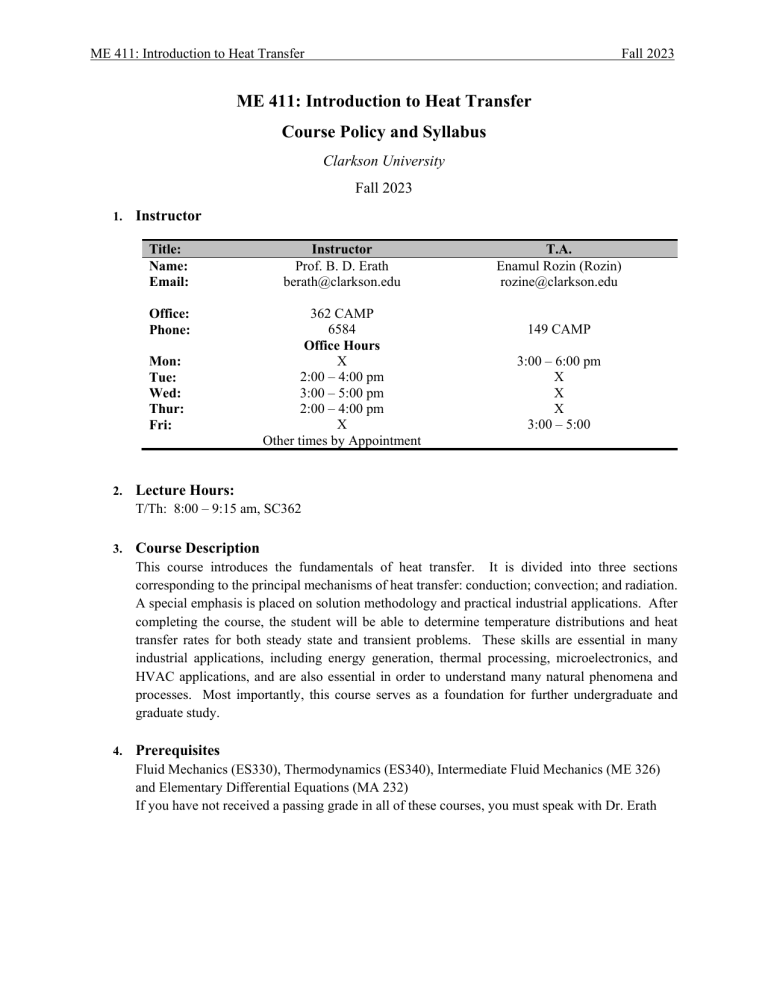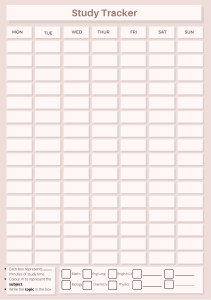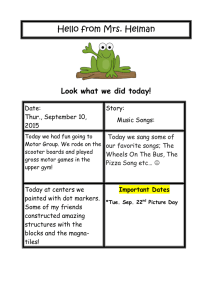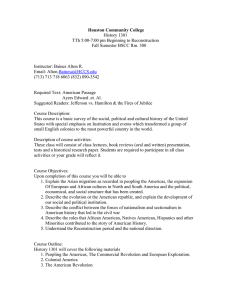
ME 411: Introduction to Heat Transfer Fall 2023 ME 411: Introduction to Heat Transfer Course Policy and Syllabus Clarkson University Fall 2023 1. Instructor Title: Name: Email: Instructor Prof. B. D. Erath berath@clarkson.edu Office: Phone: 362 CAMP 6584 Office Hours X 2:00 – 4:00 pm 3:00 – 5:00 pm 2:00 – 4:00 pm X Other times by Appointment Mon: Tue: Wed: Thur: Fri: 2. T.A. Enamul Rozin (Rozin) rozine@clarkson.edu 149 CAMP 3:00 – 6:00 pm X X X 3:00 – 5:00 Lecture Hours: T/Th: 8:00 – 9:15 am, SC362 3. Course Description This course introduces the fundamentals of heat transfer. It is divided into three sections corresponding to the principal mechanisms of heat transfer: conduction; convection; and radiation. A special emphasis is placed on solution methodology and practical industrial applications. After completing the course, the student will be able to determine temperature distributions and heat transfer rates for both steady state and transient problems. These skills are essential in many industrial applications, including energy generation, thermal processing, microelectronics, and HVAC applications, and are also essential in order to understand many natural phenomena and processes. Most importantly, this course serves as a foundation for further undergraduate and graduate study. 4. Prerequisites Fluid Mechanics (ES330), Thermodynamics (ES340), Intermediate Fluid Mechanics (ME 326) and Elementary Differential Equations (MA 232) If you have not received a passing grade in all of these courses, you must speak with Dr. Erath ME 411: Introduction to Heat Transfer 5. Course Objectives and outcomes [ABET criteria] Course Learning Outcomes Identify which of the three primary modes of heat transfer that are important in a heat transfer problem Determine temperature distributions and heat transfer rates for both steady and transient problems having conductive, convective, and radiative heat transfer Compute convection coefficients for external and internal flows for both forced and free convection Find and use heat transfer correlations from literature or other appropriate sources Determine total radiative material surface properties from spectral behaviors, and compute radiative heat transfer between surfaces 6. Fall 2023 ABET Outcomes 1 Assessment Tool Homework assignments, quiz, and exam questions 1 Homework assignments, quiz, and exam questions 1 Homework assignments, quiz, and exam questions 7 Homework assignments 1 Homework assignments, quiz, and exam questions Textbook Incropera, F. P., DeWitt, D. W., Bergman, T. L., Lavine, A. S., Fundamentals of Heat and Mass Transfer, 8th Ed., John Wiley and Sons, New York NY. Each student MUST have a hard copy of the book. (The accompanying loose-leaf version is acceptable). 7. Announcements All announcements including homework assignments will be made through Moodle. http://moodle.clarkson.edu/ 8. Reading Assignments Reading assignments outlined in the syllabus should be completed before class. Every Friday before 5 pm students must log into Moodle and indicate whether they completed the weekly reading assignment for that week before class, or not. A self-assigned score for each reading assignment will be entered using the following metric: 0 – No reading was completed 1 – Partial completion of the reading assignment 2 – Completion of the reading assignment 9. Homework Homework will be assigned weekly on (usually) Thursday. It will be due (usually) the following Thursday. Homeworks will not be graded, but will be critical for quiz performance. ME 411: Introduction to Heat Transfer Fall 2023 10. Quizzes There will be a quiz each day that homework is due. The quiz will be a short (5-10 minute) assessment of whether you completed and understand the homework. It will consist of either (1) short computational problems that are the same as concepts covered on the homework, or (2) short answer/conceptual questions that address homework topics (sample questions will be provided with each homework assignment). 11. Exams Two midterms and one final exam will be administered. Both midterm exams will be based on topics from the reading, lecture, and homework. The exams will be open book, and students are allowed to have a graphing calculator. The exams will be 65 minutes in length. Final Exam: The final exam will consist of two parts; 1) a regular exam over the last section of the course (Radiation) and 2) a comprehensive review of the entire class (Conduction, Convection, and Radiation). Exam Regrades: If you feel something was graded incorrectly on an exam, you must submit a formal appeal within 1 week of the exam being handed back, but no sooner than 24 hours after it is handed back. The original exam must be handed back in with the regrade request. There should be NO additional writing on the original exam other than what was initially written. The form for requesting regrades can be found on Moodle. 12. Attendance Class attendance is not required; however, no make-up will be given for either quizzes or exams unless it meets one of the following exemptions: 1) 2) 3) 4) University sponsored trips Death of an immediate family member Documented illness Extenuating circumstances For the first exemption, an email must be sent to Prof. Erath within two weeks of the start of the semester. For all other exemptions, documentation from a medical doctor must be provided. Extenuating circumstances will be determined solely at the discretion of Prof. Erath, and must be provided at least one week before the exam. For scheduled absences (e.g. University related trips) homework must be turned in before leaving on the trip. 13. Academic Honesty Policy All examinations and other graded assignments are to be completed in conformance with Clarkson Universities Code of Academic Integrity available at http://www.clarkson.edu/studentaffairs/regulations/iv.html. Cheating, copying, and/or plagiarism ME 411: Introduction to Heat Transfer Fall 2023 on graded materials will not be tolerated. Any instances of cheating, copying, or plagiarism will be prosecuted in accordance with the university and department policies. Although students are encouraged to collaborate on homework assignments, collaboration of any sort on the quizzes, midterm, and final exams is not allowed. Cheating is defined as representing someone else’s work as your own. This includes following, and writing down the work of another classmate when you do not understand the solution. In addition, providing results to another student, receiving other’s results, presenting their material as if it is yours, and copying from other’s designs, reports, and problem sets is strictly forbidden. Any use of generative artificial intelligence (AI) is also expressly forbidden, and will be considered cheating. Any instance of cheating will constitute a violation of the Clarkson University Code of Ethics. It is unacceptable to use the internet as a resource to find and prepare solutions to homework problems! This is your first and only warning! Violation of this policy will result in a failing grade for the course (F) and will be reported to the Academic Integrity Committee. According to Clarkson University Policies students that are found to violate the Clarkson University Code of Ethics have to right to appeal to the Academic Integrity Committee. 14. Disabilities Any student who may need an accommodation based on the potential impact of a disability should contact the AccessABILITY Services at (315) 268-7643 (1003 Price Hall) to establish eligibility and to coordinate reasonable accommodations. For additional information please refer to: http://www.clarkson.edu/oas/ Accommodations must be arranged during the first two weeks of the semester. Students needing accommodations should contact Prof. Erath privately to discuss specific needs. 15. Grading Grade distributions are as follows Reading 5% Quizzes 20% Exams 1 and 2 40% Exam 3 and Final Exam 35% The following percentiles will guarantee at least the corresponding grade: 94 – 100%: A 90 – 93%: A87 – 89%: B+ 84 – 86%: B 80 – 83%: B77 – 79%: C+ 74 – 76%: C ME 411: Introduction to Heat Transfer Fall 2023 70 – 73%: C60 – 69%: D 16. Keys to Success In order to perform well on examinations and quizzes in the course, you must not only understand how to solve problems in heat transfer, but also be comfortable with the physical concepts. Exams and quizzes are developed to test your understanding through problem solving, short answer, and conceptual questions. The keys to success are: a. Recognizing that this is a difficult course, and proper preparation is required. An average student wishing to receive an average (B – C) grade should spend ~ 7-8 hour/week on this course, every week. b. As a Junior/Senior level course, there is a large amount of mathematical development that is necessary. Consequently, lectures, homework, and exams will require a relatively high degree of comfort with previous math classes (Primarily calculus, and partial and ordinary differential equations) c. Preparing for lecture by not just completing the assigned reading, but understanding the assigned reading. The bulk of your time should be spent preparing for lectures, reading the textbook and reviewing class notes to understand the material. d. Attending and participating in the lectures. e. Completing and studying all of the homework assignments. Homework is assigned for you to assess your level of comprehension. If you fully-understand the material, you should be able to sit down and complete the assignment in a timely manner. There is a twenty dollar bill hidden behind the heat transfer picture on the corkboard outside my office door. The first person to find it gets to keep it. Inability to do this will indicate areas you should go back and review/study. f. Practical studying tips: Make flash cards of the new terminology (there is a lot!). 17. Schedule (Subject to change) 18. Date Aug 29 (Tue) Aug 31 (Thur) Sep 5 (Tue) Sep 7 (Thur) Sep 12 (Tue) Sep 14 (Thur) Sep 19 (Tue) Sep 21 (Thur) Sep 26 (Tue) Sep 28 (Thur) Oct 3 (Tue) Oct 5 (Thur) Oct 10 (Tue) Oct 12 (Thur) Oct 17 (Tue) Oct 19 (Thur) Oct 24 (Tue) Oct 26 (Thur) Reading Ch. 1 1.3, 2.1-2.2 2.3-2.4 , 3.1 3.1 3.3, 3.5 3.5, 3.6 3.6, 4.1-4.3 5.1-5.3 5.4-5.5 5.4-5.5 5.6 6.1 – 6.3 N.A. 6.4-6.5, 7.1 7.2 7.4-7.5 8.1-8.2 Lecture Topic Course Introduction, Modes of Heat Transfer Relationship to thermodynamics, Intro to conduction Diffusion equation, boundary conditions, Plane wall conduction Thermal circuits, Radiation boundary condition, contact resistance Radial system, Volumetric heat generation Heat generation (cont.) Fins and extended surfaces. Fins (cont.), Multidimension conduction, shape factors Trans. conduction, lumped capacitance Trans. conduction, plane wall Trans. conduction, plane wall (cont.) Trans. conduction, radial geometries Introduction to convection, Boundary layers Fall Break Exam I: TBD Boundary layer equations, External flow over a flat plate (laminar) Review Exam I, External flow over a flat plate (mixed, turbulent) External flow over a cylinder, sphere Internal flow: entry length, fully-developed ME 411: Introduction to Heat Transfer Oct 31 (Tue) Nov 2 (Thur) Nov 7 (Tue) Nov 9 (Thur) Nov 14 (Tue) Nov 16 (Thur) Nov 22 (Tue) Nov 23 (Thur) Nov 28 (Tue) Nov 30 (Thur) Dec 5 (Tue) Dec 7 (Thur) Dec 11-Dec 15 8.2-8.3 8.4-8.5 9.1-9.4 9.5-9.6, 9.8 12.1, 12.3 N.A. 12.4-12.5 12.5 12.5 – 12.8 13.1-13.2 N.A. Fall 2023 Internal flow: energy balance, temperature Internal flow: temperature (cont.), convection, overall heat transfer rate Introduction to natural convection, vertical surfaces Natural convection: cylinders, spheres, enclosures Introduction to radiation. Radiation quantities and processes Exam II: TBD Blackbody radiation, surface properties Thanksgiving break Review Exam II, Characteristics of real surfaces Real surfaces, Kirchoff’s law, grey surfaces View factors, Heat transfer between black surfaces Catch-up lecture/Review Final Exam





